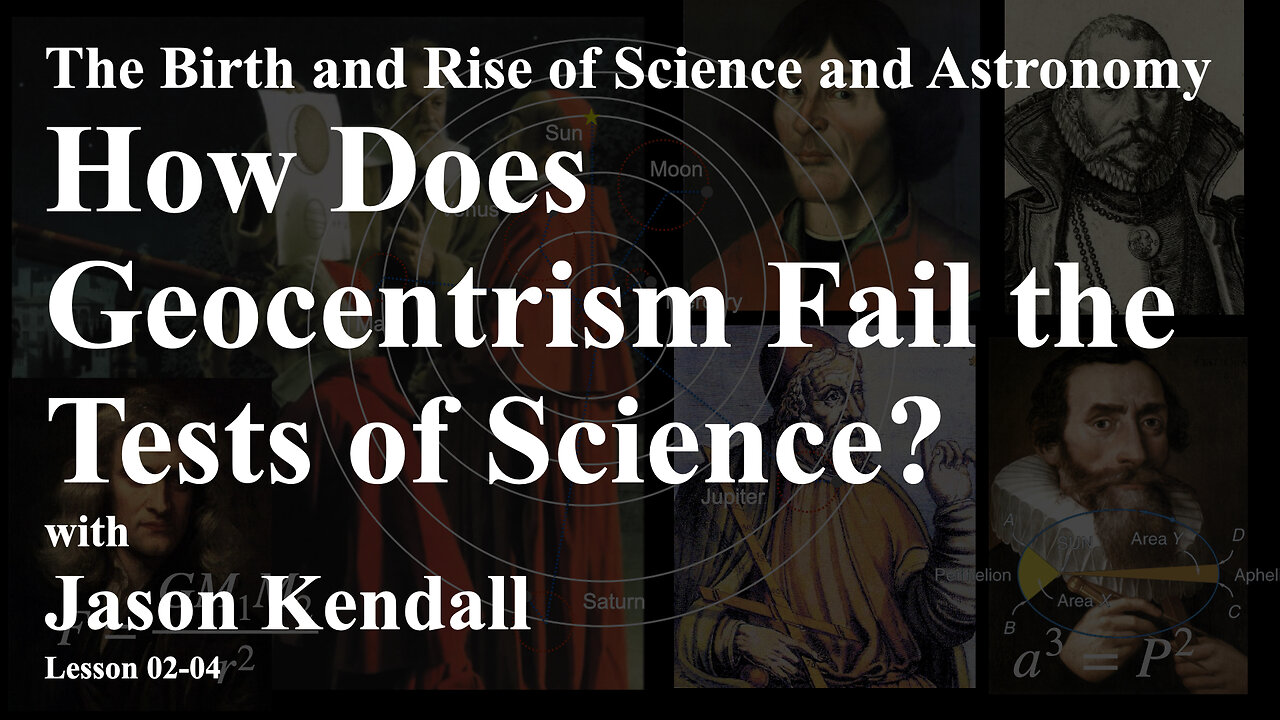Premium Only Content

From Geocentric to Heliocentric: The Evolution of Our Understanding of Planetary Motions
In this presentation, we embark on a comprehensive exploration of the historical journey that culminated in the understanding of planetary motions and the subsequent realization that the Earth is not the center of the universe, but rather, it orbits around the Sun. This pivotal realization has been instrumental in shaping modern physics and scientific thought. The narrative begins with ancient astronomers who, through meticulous observation of the night sky, discerned that while the majority of stars remained fixed in their celestial positions, certain celestial bodies, later identified as planets, exhibited unique movements across the sky. The term “planet” is derived from the Greek word “planetes”, which translates to “wanderers.” Among the celestial bodies classified as planets are the Sun, Moon, Mars, Mercury, Venus, Jupiter, and Saturn. These planets typically exhibit prograde motion, which describes their general eastward movement against the backdrop of fixed stars. However, there are instances where planets appear to reverse their direction, a phenomenon known as retrograde motion. This retrograde motion is particularly pronounced in Mars, making it a significant subject of study for astronomers attempting to understand planetary orbits. Ancient astronomers made the critical observation that planets reflect sunlight and hypothesized that their diminished brightness was due to their greater distance from both the Sun and the Earth. This understanding prompted early scientists, often referred to as mathematicians, to engage in the study of celestial motions primarily for calendar creation and astrological practices. The prevailing cosmological framework at the time was the Geocentric Model, which placed the Earth at the center of the cosmos. This model was championed by the esteemed philosopher Aristotle (384-322 BC), who posited that the Earth was stationary and that all celestial bodies revolved around it. Aristotle’s arguments were grounded in various observations, including the absence of significant winds and the consistent behavior of falling objects, which suggested that the Earth was immobile. The Geocentric Model was further refined by Claudius Ptolemy (circa 140 AD) in his seminal work, the Almagest. Ptolemy’s model became the dominant astronomical paradigm for over a millennium and introduced the complex systems of epicycles and deferents to explain the motions of the planets. In Ptolemy’s conception, each planet was embedded in a circular orbit, which itself moved along a larger celestial sphere. While the Geocentric Model provided relatively accurate predictions of planetary positions and guided astronomical study, it ultimately proved inadequate in explaining the observed motions of celestial bodies. The model’s reliance on intricate mechanisms of epicycles was a significant factor in its eventual decline. The transition towards a more accurate understanding of planetary motions began in earnest during the Renaissance of the 16th century. This period marked a significant intellectual shift, wherein scholars began to challenge established beliefs and seek empirical evidence to support new hypotheses. The heliocentric model, which posited that the Sun, rather than the Earth, was at the center of the universe, was first proposed by Nicolaus Copernicus. In his groundbreaking work, De revolutionibus orbium coelestium, Copernicus sought to simplify the mathematical complexities of the Geocentric Model by placing the Sun at the center. However, even Copernicus’s heliocentric model initially relied on the assumption of perfect circular orbits, which did not substantially simplify the mathematical computations relative to Ptolemy’s system. Despite initial resistance and limited acceptance of Copernicus’s ideas—partly due to the entrenched geocentric views supported by both the church and Aristotelian philosophy—his work laid the groundwork for further astronomical advancements. The contributions of Tycho Brahe and Johannes Kepler greatly facilitated the eventual acceptance of the heliocentric model. Brahe’s meticulous observations of Mars’ position over a two-decade span provided invaluable data for his successors. Following Brahe’s death, Kepler gained access to his extensive data and made revolutionary discoveries regarding planetary motion. Kepler abandoned the notion of perfect circular orbits and proposed that planets move in elliptical paths. He formulated three fundamental laws of planetary motion: (1) Planets orbit the Sun in ellipses with the Sun located at one focus; (2) A line segment joining a planet and the Sun sweeps out equal areas during equal intervals of time; (3) The square of the orbital period of a planet is proportional to the cube of the semi-major axis of its orbit (harmonic law). Kepler’s work, published in 1609 and 1619, established a foundation for modern astrophysics by grounding his laws in empirical data. This presentation serves to highlight the transition from the geocentric to the heliocentric model, illustrating how scientific thought evolved through rigorous observation, improved accuracy, and the abandonment of long-held beliefs in perfect celestial circles. The historical journey of understanding planetary motions has not only shaped our comprehension of the cosmos but has also laid the groundwork for future advancements in scientific inquiry. In our subsequent discussions, we shall delve into the contributions of Galileo Galilei and the further development of Newtonian mechanics, which ultimately solidified the heliocentric view of our solar system. As we reflect on this remarkable evolution of thought, it is essential to appreciate the collaborative nature of scientific discovery and the enduring quest for knowledge that characterizes the field of astronomy.
-
 LIVE
LIVE
FusedAegisTV
13 hours agoStreet Fighter 6 FINALS, CS2 Semifinals | $1,250,000 | Riyadh, Saudi Arabia EWC 2025 !estv
175 watching -
 40:42
40:42
SouthernbelleReacts
1 day ago $0.06 earned😂 American Pie (1999) Reaction | Iconic Teen Comedy, High School Chaos & 90s Nostalgia 🥧
18.7K2 -
 LIVE
LIVE
LumpyPotatoX2
4 hours agoBecome a HellDiver Today - #RumbleGaming
217 watching -
 4:52:02
4:52:02
Midnight In The Mountains
5 hours agoGaming w/ PER·SE·VER·ANCE | Sassy Saturday Fortnite | with the Midnights!
17.6K3 -
 LIVE
LIVE
shyboyking
4 hours agoThe Bots Of The Bots !!!😎
171 watching -
 24:06
24:06
True Crime | Unsolved Cases | Mysterious Stories
5 days ago $0.19 earnedShe Traveled Alone… and Never Came Back – 5 Mysterious Unsolved Cases (Part 6)
20K6 -
 27:23
27:23
Clickbait Wasteland
17 hours ago $0.04 earnedAsking New Yorkers Who They Support For Mayor: Staten Island
24.3K12 -
 16:58
16:58
World2Briggs
1 day ago $0.05 earnedThe California Rant: Point Blank With No Fluff or BS. California Gold?
15.4K4 -
 17:49
17:49
Chris Harden
2 days ago $0.02 earnedThe Glass Capital That Shattered | The Decline of Streator, Illinois
11.3K4 -
 51:15
51:15
JohnXSantos
3 days ago $0.01 earnedClothing Brand Manufacturers + Winners
7.29K2